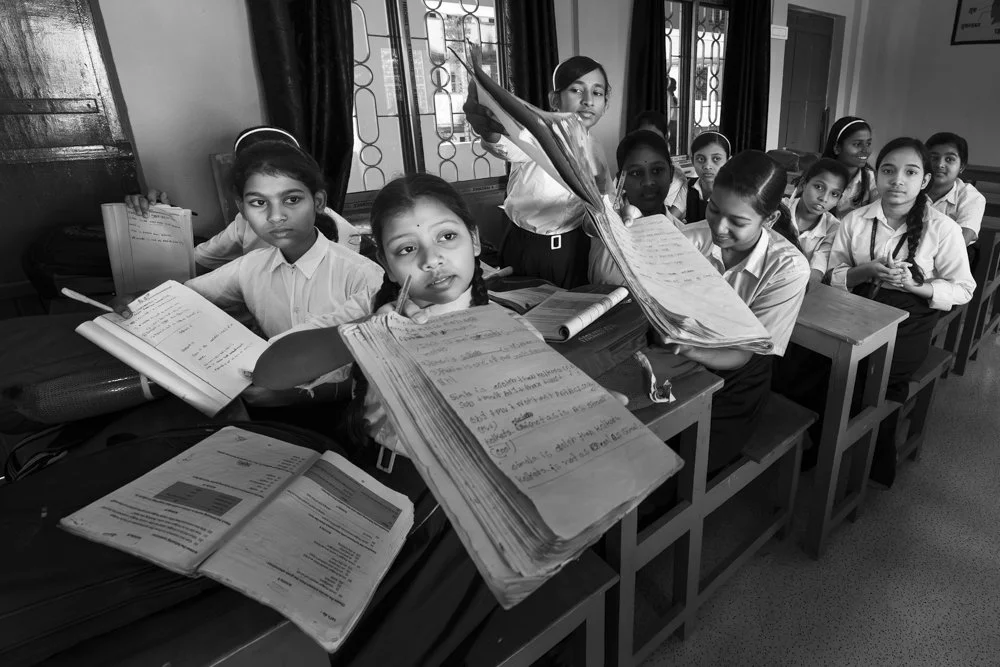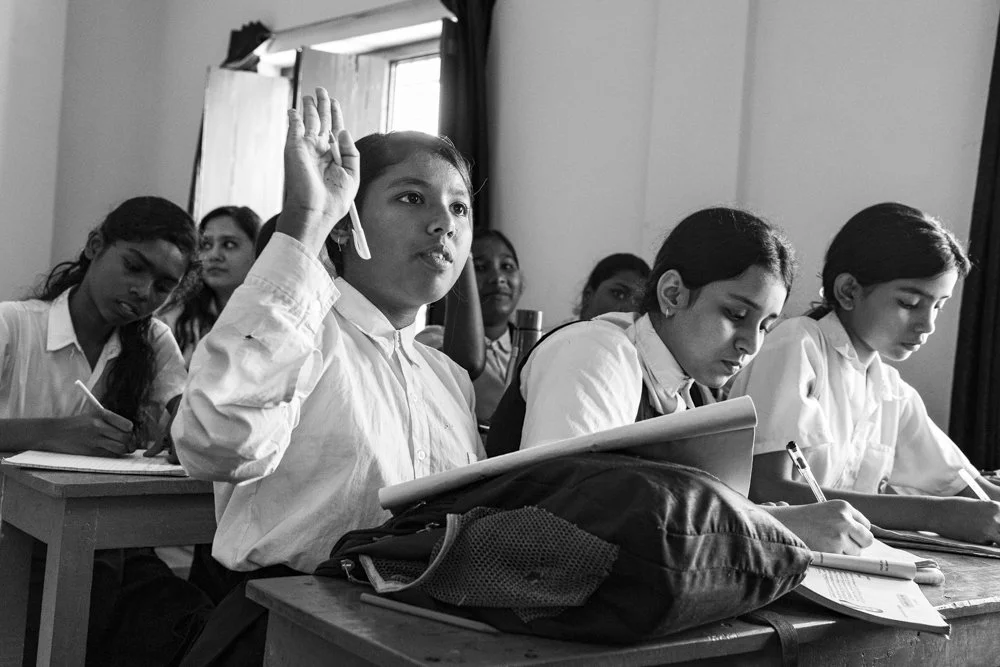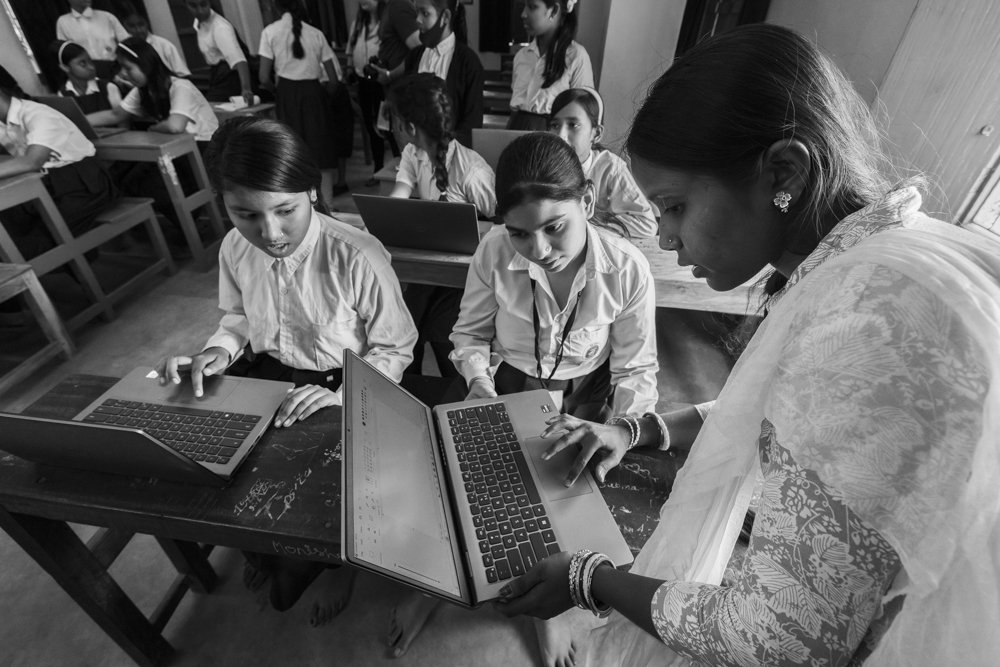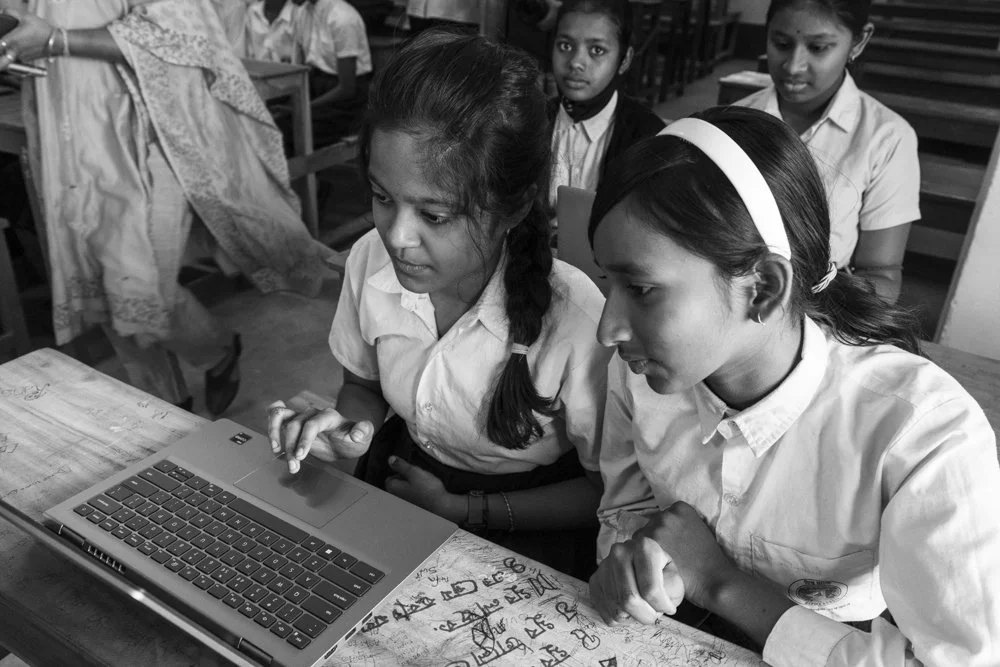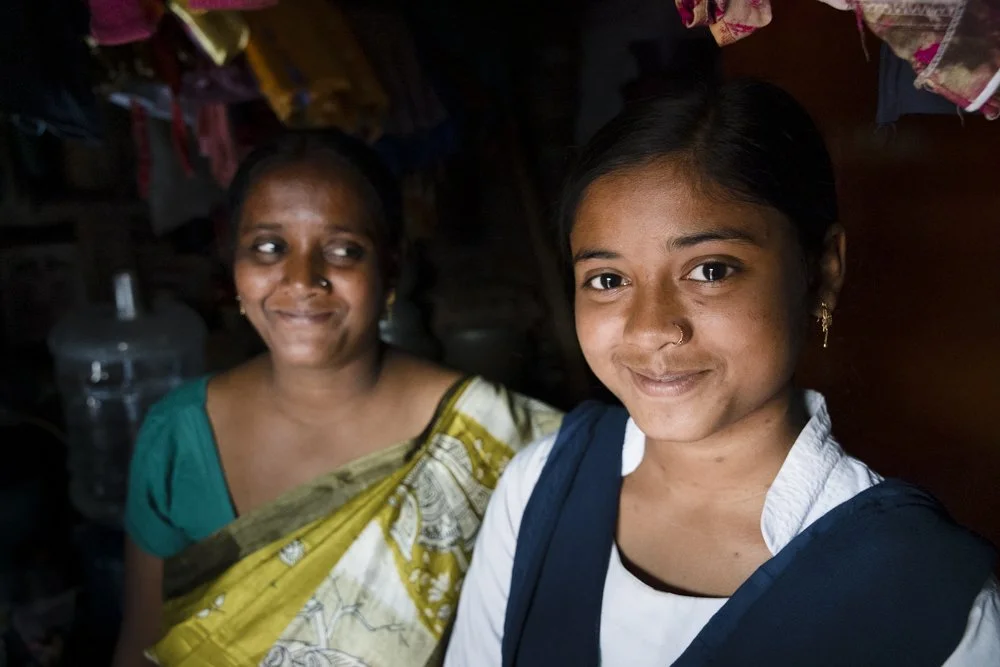Female Education India: Education as Empowerment for Girls
Schoolgirls in Howrah, West Bengal receive instruction in digital literacy. Photograph: ©Steven Wade Adams, West Bengal, India 2025
This blog is the second in a series of four articles that describe my experience in Bihar and West Bengal in March 2025, documenting the work of C3 India (Center for Catalysing Change India) to support women’s empowerment.
My previous article in this series provided an overview of how C3 India is supporting feminism in India.
Education for Empowerment: Digital and Financial Literacy
This article focuses on the work being done in Bagnan Adarsha Balika Vidyalaya, in the Uluberia Block, of Howrah, West Begal to support girls’ education with particular focus on the development of digital and financial literacy as a path to empowering young girls.
This program supports a range of other activities that comprehensively encourage the support of young girls to stay in school and develop a stronger sense of personal agency.
C3 India has been working closely with their sponsors, local officials and teachers to incorporate methodologies known to advance empowerment of adolescent girls and thereby address some challenging social issues.
To represent the scope and impact of this work, I photographed the girls in class, at play, and hanging out at their homes in the nearby village.
C3 India: An Advocate for the Education of Girls in India
Adolescent girls in West Bengal face a multitude of barriers that significantly impact their well-being, development and life potential. These cultural and socioeconomic factors often lead to limited access to education, as many girls are forced to leave school early to contribute to household income or marry very young.
The resulting lack of educational opportunities restricts their life choices, potential for empowerment and ultimately, the scale of their contributions to society.
Cultural norms and gender-based discrimination, which are common in India, further compound their struggles, as they may encounter restrictions on mobility and decision-making. Further, a range of health issues, including inadequate access to reproductive health services and widespread prevalence of nutritional deficiencies, also pose serious threats to their overall welfare.
These combined challenges create an overall environment that can hinder the growth and aspirations of adolescent girls in the region. This set of issues represents the target of the interventions led by C3 India at this school in Howrah.
Enthusiastic girls are eager to demonstrate their comprehension of English and advanced sentence structure. Photograph: ©Steven Wade Adams, West Bengal, India 2025
Supporting Female Education in India
Luckily, some significant efforts from organizations such as C3 India are making a real impact to empower adolescent girls with greater agency and improved health by supporting the development of a range of life skills in female education projects such as ‘Manushi’.
Manushi is a multi-layered approach to connect young girls to essential information that promotes their well-being and supports them to stay in school to complete their education while strengthening their digital and financial literacy.
The open dialog with the girls also inspires them to challenge gender norms and explore diverse career aspirations that are often challenging for them to otherwise imagine, much less execute.
Engaged students in a classroom at girls school in West Bengal, India. Photograph: ©Steven Wade Adams, West Bengal, India 2025
Manushi Program: Delivering Life skills Education in Schools in India
Like other successful programs, C3 India works in close alignment with the government agencies and the schools to align on the approach and provide critical support on the ground. The key goals and objectives of this program are focused on the unique needs of young girls in India which are summarized below.
The organization also provided the digital boards for the classrooms and worked with the schools to modify the curriculum to maintain engagement while utilizing these modern technologies.
C3 India provides support to enhance engagement and support education in alignment with school objectives while enhancing agency and self-empowerment of adolescent girls. Photograph: ©Steven Wade Adams, West Bengal, India 2025
While at the school, it was clear the girls were embracing the opportunity to excel in English, science, and mathematics, as well as be engaged in a specific focus on digital and financial literacy. The ultimate goal is to arm these young girls with the knowledge, skills, and opportunities to achieve the capacity for financial independence and lead a life of dignity.
In addition to photographing and interacting with the students, I was equally curious about the journey of the successful teachers as well. The computer science instructors are especially central to this program in the Howrah school.
This is what Rimpa Denre, a School Coordinator at the Centre for Catalyzing Change organization, had to share about herself.
“I am a resident of Howrah district….completed my B.Sc with Honours in Botany from Calcutta University and obtained a diploma in Information Technology Applications in Computer, along with a course in Tally (Accounting Inventory Management Software). I worked as a computer instructor at the National Youth Computer Centre, and after that, I served as a computer instructor for 2 years at Bagnan”
Digital literacy development for adolescent girls in West Bengal, India. Photograph: ©Steven Wade Adams, West Bengal, India 2025
Lifeskills Education in Schools: Key Objectives of the Manushi Program
Promoting Informed Health Decisions: The initiative emphasizes the importance of informed decision-making in areas such as nutrition, sexual health, and general wellness. Through educational workshops and resources, Indian girls learn how to make choices that contribute to their overall health.
Improving Access to Health Services: Access to health services is paramount for female adolescents in India to seek help when it is needed. The partnership works to bridge gaps in knowledge about available health services, empowering students to take charge of their well-being and encouraging them to seek assistance from appropriate sources.
Preventing Child Marriage: One of the pressing issues in many communities is the prevalence of child marriage. Education plays a crucial role in combating this practice. By raising awareness about the rights of children and the importance of education, the initiative aims to prevent child marriages and enable female adolescents to pursue their dreams without these interruptions.
Enhancing Digital and Financial Skills: In an increasingly digital world, young individuals need to possess essential digital literacy and financial skills. A core element of this initiative is literacy in digital tools and financial management, equipping students with the competencies required for future employment as well as informed financial decision-making.
Improving Hygiene and Menstrual Hygiene Management: Addressing hygiene and menstrual health is critical for the well-being of female adolescents in India. The initiative includes educational components that include WASH (Water, Sanitation, Hygiene) and menstrual hygiene management, ensuring that the girls have access to accurate information and resources to manage their health responsibly and confidently.
Witnessing the Engagement of Students and Teachers in the Classrooms of West Bengal, India
Young girls develop digital literacy at their school in Howrah, West Bengal. Photograph: ©Steven Wade Adams, West Bengal, India 2025
It was so fun to witness the girls at school in Howrah, West Bengal. They were the core element of a vibrant atmosphere as they actively engaged in learning subjects like English, science, computer skills, and financial literacy.
The classroom was literally brimming with enthusiasm and pride as they participated in discussions, practiced new vocabulary, worked collaboratively on digital projects and discussed real-world applications of financial literacy.
I am pleased the images captured a slice of the strong feelings of joy and engagement that were so palpable in each of these classrooms, and I left inspired by the work of this program to contribute to a brighter future for these young learners.
Visiting Students in their Homes in Howrah, West Bengal
Madhumita discusses her day at school with her mother in her family’s two room home in Howrah, India. Photograph: ©Steven Wade Adams, West Bengal, India 2025
As much as we enjoyed the time to witness the interventions in the classroom, I was curious to learn more about the underlying problems being addressed and the impact of the program at a practical level.
I was aware that social surveys had indicated that West Bengal suffered a particularly high rate of child marriage and low rates of girls’ education, so I wondered what it was like for these girls at home and the barriers they might face in obtaining a complete education.
Luckily, my C3 India hosts arranged a visit to the nearby village, where we visited several of the girls attending the school and their families. Within the village, we were able to visit the modest homes for which they exhibited great pride.
I felt privileged to photograph Madhumita Bodhak and her mother within their private space and learn about how the school education program had impacted how the family communicates and thinks about the future of their daughter. It has provided them with awareness of all of the potential that their daughter has in the world to grow into an empowered young woman.
Challenging Gender Stereotypes
Madhumita explained that the school program has provided her so many new ideas and ways of thinking about issues such as gender and social class, and she has since been able to bring robust dialog to discussions with her family and helping all of them to also explore alternate narratives and possibilities for her education and future.
She explained that as a result of the exposure she had been getting at school and the Manushi program, when cultural and gender role issues were raised through TV or other media, Madhumita was in a position to lead family conversations in a manner that is a significant departure from what had been typical in this region. She is very ambitious and shared her dream with us.
“When I grow up, I want to become a doctor. Because I want to help people, serve them, and bring change in their lives. There is a special satisfaction in serving people. In our village, there are many poor families who do not get proper medical treatment. I want to stand by those underprivileged people by treating them.”
So in a very real way, this experience of empowerment and female education in India, at school, has allowed the opportunity to practice agency by challenging convention and find a more active voice as to what her future might look like. It was evident that in Madhumita’s home, this confidence and self-worth was valued as it was clear that Madhumita’s mother exuded pride for her young daughter.
As an aside, In September of 2024 (just 6 months before my visit), large swaths of West Bengal were struck by massive floods brought on by heavy rains and worsened through a controversial release of water from nearby dams. Many of the homes in the region were no longer habitable, leaving hundreds of thousands of people suddenly homeless. Luckily for this family, Madhumita’s uncle owns the house where they are currently living in Howrah, so that she and her family could have an acceptable shelter.
The pride Madhumita’s mother has for her daughter is obvious. Photograph: ©Steven Wade Adams, West Bengal, India 2025
Our time in the neighborhood was a very special experience connecting with the residents, but sadly was all too brief. The residents of the village rarely receive foreigners, and they were beyond excited to show us their homes and welcomed us in to chat and photograph. The entire neighborhood was exuberant with pride and excitement.
I could have happily continued to photograph there for days. I hope to return to West Bengal in the years ahead to check in on Madhumita and see how she and her peers continue to mature, advance their education and sense of agency and empowerment.
Sushmita stands outside her home in a village within Howrah, West Bengal. Sushmita wants to grow up to be a nurse. “I want to serve the people in the village and help them become healthy”. Photograph: ©Steven Wade Adams, West Bengal, India 2025
An Award for the Program!
Immediately following my visit to Bengal, C3I received notice they were honored with the Winner Award in the 'Promoting Education' category at the 7th ICC Social Impact Awards 2025 - a great testament to the strength of the organization, its people and the program outcomes.
Curious girls at the girls school welcome me to their classroom in Howrah, West Bengal. Photograph: ©Steven Wade Adams, Howrah, West Bengal, India 2025
Inspiring Future Generations and Positive Change
This initiative aims to create a new generation of informed, healthy, and empowered girls and women.
By recognizing the many challenges faced by girls in India, such as child marriage and early withdrawal from education, C3 India has worked with the local communities and the schools to provide enhanced female-focused education and life skills, with special focus on digital and financial literacy.
The story of these girls in Howrah is one of hope, and I am privileged to have met so many of the girls engaged in the program, their teachers and supportive family members.
Female Education in India: Empowerment for Girls
If you enjoyed this, you may also like my earlier article in this series dedicated to feminism in India, which explored some of the barriers to female empowerment in India.
Subscribe to my newsletter and be among the first to read the upcoming article in this powerful 4-part series.
In my next article, I will share my visit with a Village Level Organization that supports and grows women’s entrepreneurship as a path to empowerment. Other future blogs will explore the critical role of women’s empowerment in the delivery of health care.


